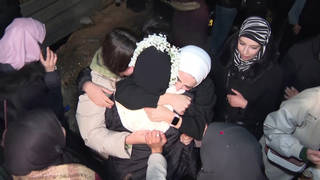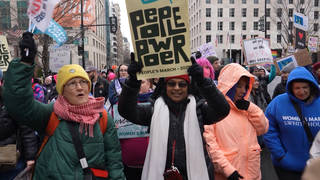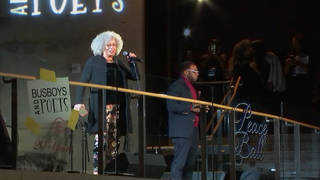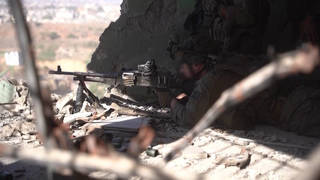
Related
Guests
- Robert WallaceVisiting professor in the Department of Geography at the University of Minnesota and author of the forthcoming book Farming Human Pathogens: Ecological Resilience and Evolutionary Process. He blogs at Farming Pathogens.
As the US reports its first known death from the global swine flu, the World Health Organization has raised its pandemic threat level. Several countries around the world have banned the import of US and Mexican pork products. We speak to professor and author Robert Wallace, who says the swine flu is partly the outcome of neoliberal policies that forced poorer countries to open their markets to poorly regulated Western agribusiness giants. [includes rush transcript]
Transcript
AMY GOODMAN: As fears of a possible worldwide pandemic of swine flu continue to grow, the World Health Organization raised its pandemic threat level Tuesday, and WHO chief Keiji Fukuda said a pandemic was a “very serious possibility” but still not inevitable.
Mexican health authorities confirmed seven deaths but put the suspected death toll from swine flu at 159 and said over 2,500 people have been sickened. New cases have appeared in cities across the United States and in Australia, Canada, Spain, Israel, Britain and New Zealand. Suspected cases are being investigated in countries across Europe, Asia and Latin America.
With sixty-five confirmed cases in the United States, forty-five of which are in New York, President Obama asked Congress for $1.5 billion in supplemental funding.
The United Nations Food and Agriculture Organization, meanwhile, is sending a team to Mexico to investigate claims that industrial pig farms were the source of the outbreak in humans. Several countries around the world have banned the import of US and Mexican pork products. The pork industry has raised concerns over the nomenclature of the influenza strain and is lobbying to call the virus by its scientific name, H1N1.
I’m joined now via Democracy Now! video stream from Minneapolis by Robert Wallace, who has written extensively about avian influenza. He is a visiting professor in the Department of Geography at the University of Minnesota. He’s author of the forthcoming book Farming Human Pathogens: Ecological Resilience and Evolutionary Process. He blogs at farmingpathogens.wordpress.com.
Welcome to Democracy Now!, Robert Wallace. Start off by just explaining what is the swine flu.
ROBERT WALLACE: Well, the swine flu is a influenza. It’s influenza A H1N1. The “H” refers to hemagglutinin molecule. That’s a molecule on the surface of the influenza that allows the virus to key into its target cell. “N” refers to neuraminidase. That’s the molecule also on the surface of the influenza, but it allows the influenza, once it’s born, to key out of the cell that it’s been replicated in. And there are sixteen different types of H hemagglutinins and nine different types of neuraminidases. And so, they can recombine in different combinations. We have in this case H1N1.
That was the pathogen that caused the 1918 pandemic, which killed 50 to 100 million people around the world. Since that time, descendants of that pandemic strain have become less virulent and become seasonal influenza that we — some of us are infected with from one winter to the next.
This H1N1 — excuse me — is entirely different, in the sense of that it does have H1, and it does have N1, but it also has genes from other organisms. So it’s not just a human pathogen. It also contains genes from pigs, genes from birds, as well as genes from — when I — influenza — genes from pig influenza, I should be very clear about that, and genes from bird influenza, as well as genes from human influenza.
And this H1N1 apparently arose in Veracruz and subsequently spread from there. It spread to states nearby, up to Mexico City, and was able to get on the international transportation network and make its way across the world.
AMY GOODMAN: Robert Wallace, you’ve called it the “NAFTA flu.” Why?
ROBERT WALLACE: Well, swine flu — in some ways, the pork industry is kind of correct. “Swine flu” is a bit a misnomer, but not in the way they think. Because of the reasons I stated, it’s actually comprised of influenzas from — that have typically infected swine, typically infected birds and humans.
But the problem is, is that puts the onus on the swine as being the cause for why this kind of influenza has come about, and it’s just that is simply not the case. The swine are not in the driver’s seat. They are not in a position to organize themselves into what are now cities of pigs that stretch around the world.
We really have to go back to the livestock revolution. Before World War II, poultry and pigs were basically farmed in backyard operations across this country. So we’re talking about poultry flocks of the size of seventy chickens. After the World War II, all those independent farming operations were — many of them were basically put under one roof and increasingly put under the control of particular corporations — Holly Farms, Tyson, Perdue. And the geography of the poultry and pork change. So, while previously pork and poultry were grown across the country, it was now grown, or they’re now raised within only a few southeastern states here in the United States. After the livestock revolution, poultry and pigs were now being grown and raised in much larger populations, so we go from seventy poultry now up to populations of 30,000 at a time. So we have cities of pigs and poultry.
That model was subsequently spread around the world. So, starting in the 1970s, the livestock revolution was brought to East Asia. You have the CP Group, which is now the fourth — world’s fourth-largest poultry company, in Thailand. That company subsequently brought the livestock revolution into China once China opened up its doors in 1980. So we have cities of poultry and pork developing around the world.
And this phenomenon goes hand in hand with the very structural adjustment programs that the IMF and the World Bank helped institute during this time. So if you’re a poor country, you’re having financial difficulties, in order to get some money to bail you out, you had to go to the International Monetary Fund for a loan. And in return, the IMF would make demands on you to change your economy in such a way that would allow you — will force you to open up your economy to outside corporations, including agricultural companies. And, of course, that would have a detrimental effect on domestic agriculture. So, small companies within poor countries could not out-compete large agribusinesses from the North that are subsidized by the industrial governments. So they’re not able to compete with them, so there’s — they either must contract their labor and land to the companies, foreign companies that are coming into their country, or they basically retire out of the business and sell their land to the large companies that are coming in. So, in other words, the spread of the cities of pork and poultry go hand in hand with this structural adjustment program.
And, of course, NAFTA is our local version of that. The North American Free Trade Agreement was signed in 1993, instituted in 1994, and has had a subsequent effect on how poultry and pigs are raised in Mexico. So, from that time, the pattern I just described, the small farmers had to either bulk up, in terms of acquiring the farms around them, acquiring the pigs around them, or had to sell out to agribusinesses that were coming in. So the Smithfield subsidiary that is now being accused of being the possible plant of origin for this H1N1 is a subsidiary of an outside corporation.
AMY GOODMAN: And what do you see, Robert Wallace, finally, about the significance of the World Health Organization saying that the global swine flu pandemic is a very serious possibility? And what needs to be done right now?
ROBERT WALLACE: Well, I mean, it is a serious possibility. I mean, there is no doubt that it can very well threaten into becoming a pandemic. It’s well on its way. In my mind, the train has left the station. The question now is whether or not it’s going to be dangerous to the point that it develops the virulence of the 1918 pandemic. That is still very much an open question.
One of the things we must keep in mind is that even if it is not currently killing a lot of people at this point — and we should be thankful that’s the case — it could still evolve a greater virulence over time. The 1918 pandemic was characterized by an outbreak in the spring and then subsequently followed by a much more deadly outbreak in the following fall. So we really have to keep an eye on how this thing evolves. And it’s very much a changing situation, as we can see from this past week, a changing situation from day to day.
AMY GOODMAN: Robert Wallace, I want to thank you for being with us, joining us by Democracy Now! video stream from Minneapolis. His forthcoming book is called Farming Human Pathogens. We’ll link to his blog at democracynow.org.












Media Options